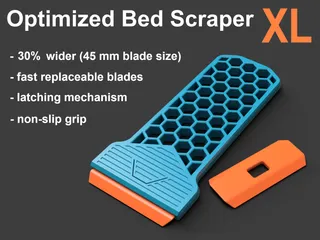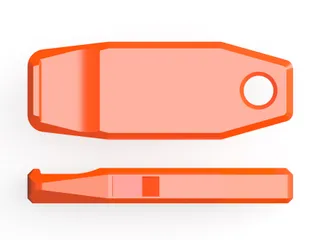Ultrasonic Dog Whistle 23 kHz
Description
PDFNews 2024-03-17: My newest whistle design, a Long Range Dog Whistle at 7,000 Hz. Please download here.  |
WARNING:
This is a dog whistle and not a toy! It's very loud which can harm the ears, so please protect your ears and don't use it near other people or animals!
About:
I wasn't sure if I should even release this whistle design with a frequency of 23 kHz - deep in the ultrasonic range. For the following reasons:
- The tiny structures in the whistle (due to the short wavelength) push an FDM printer with a 0.4mm nozzle to its limits. This design will not work on all printers.
- Virtually no human being can hear a sound of this pitch. In animals, too, the perceivable sound frequency decreases with age.
- Most smartphones can no longer record these high frequencies; at 22 kHz it usually stops. My S23 Ultra actually records almost up to 24 kHz, but all other (cheaper) devices in the family environment couldn't do that.
- Because of the (necessarily) small air openings, you have to blow quite hard to produce the sound.
Anyway - here is what will probably be my last ultrasonic whistle design for the time being. I could go higher than 23 kHz but I don't see any real benefit in it. And, to be honest, I find it rather unsatisfactory in the long run to design and test more and more inaudible whistles …
As I wrote before, you most likely won't be able to hear this whistle!
On some smartphones the function can be tested with this this android app. There are certainly similar apps for iPhones.
Please don't downgrade this design if it doesn't work.
This can definitely happen - depending on the filament and printer. But even if it works, most people won't be able to check it due to a lack of suitable equipment.
How to print:
First of all: due to the short wavelengths of ultrasound, this whistle has very small structures inside. Therefore, this print will only be successful on a very precise printer. Even small deviations (for example in the flow or the dimensional accuracy of the printer) can lead to frequency deviations or cause the whistle not to work at all.
Use a 0.4mm nozzle with a line width of 0.4 mm and a layer height of 0.2 mm, 6 top layers and 6 bottom layers.
The whistle requires correct positioning of the Z-seam - it shouldn't be placed in the narrow air passages inside the whistle. The Z-seam should be positioned as shown in the last 2 images above. Use the “Z Seam Alignment: User specified” option in Cura or the "Seam Painting" option in PrusaSlicer and Bambu Studio to achieve this.
Print slowly!
Filament selection:
It is strongly recommended not to use fancy filament types, but instead use standard PLA. Variants such as “matte”, “silk”, “glitter”, etc. should be avoided as they can affect the accuracy of the walls in the airflow.
Tags
Model origin
The author marked this model as their own original creation.




